TOYOTA AYGO X 2022 (in English) Workshop Manual
Manufacturer: TOYOTA, Model Year: 2022, Model line: AYGO X, Model: TOYOTA AYGO X 2022Pages: 494, PDF Size: 92.53 MB
Page 51 of 494
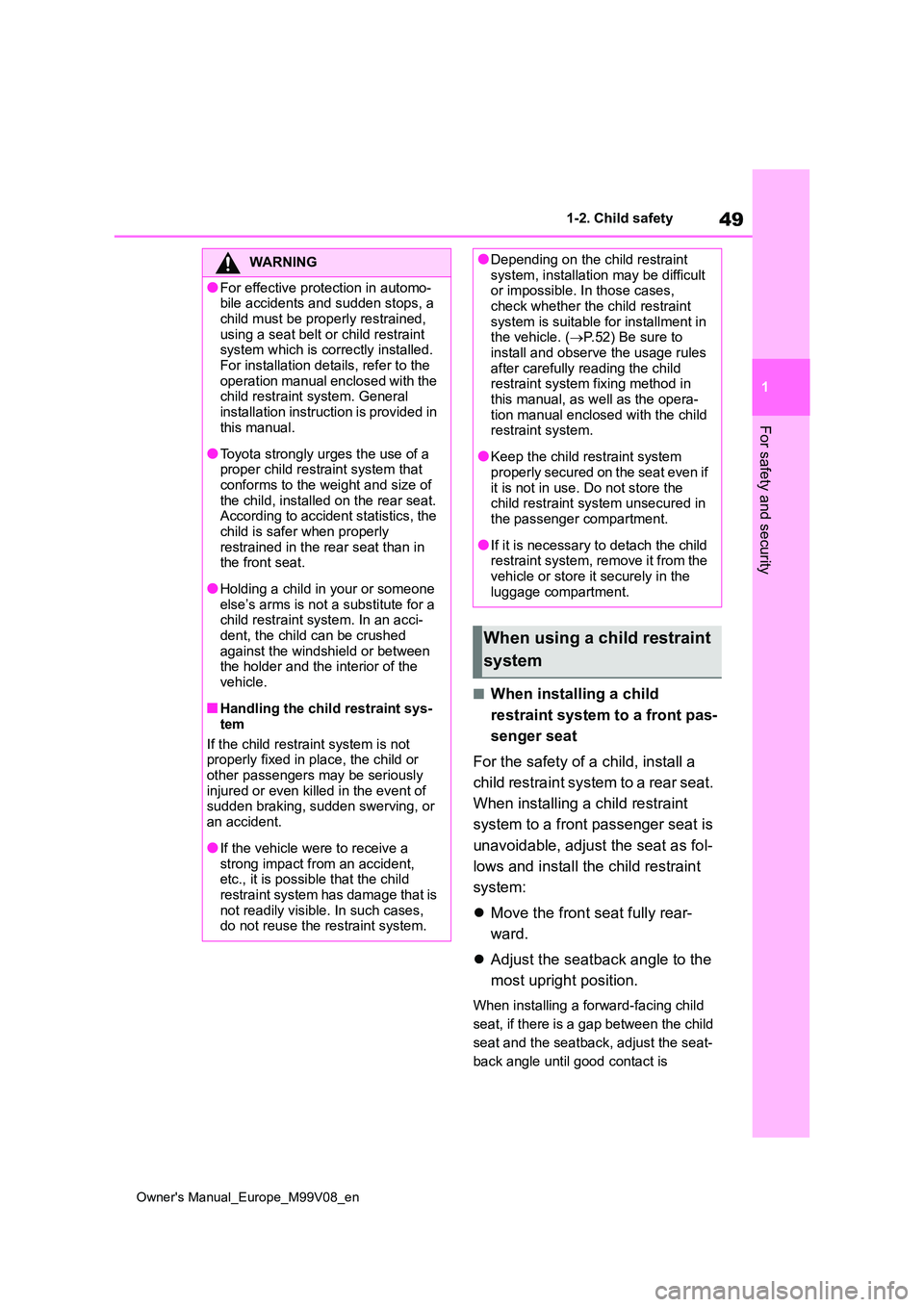
49
1
Owner's Manual_Europe_M99V08_en
1-2. Child safety
For safety and security
■When installing a child
restraint system to a front pas-
senger seat
For the safety of a child, install a
child restraint system to a rear seat.
When installing a child restraint
system to a front passenger seat is
unavoidable, adjust the seat as fol-
lows and install the child restraint
system:
Move the front seat fully rear-
ward.
Adjust the seatback angle to the
most upright position.
When installing a forward-facing child
seat, if there is a gap between the child
seat and the seatback, adjust the seat-
back angle until good contact is
WARNING
●For effective protection in automo- bile accidents and sudden stops, a
child must be properly restrained, using a seat belt or child restraint system which is correctly installed.
For installation details, refer to the operation manual enclosed with the child restraint system. General
installation instruction is provided in this manual.
●Toyota strongly urges the use of a proper child restraint system that conforms to the weight and size of
the child, installed on the rear seat. According to accident statistics, the child is safer when properly
restrained in the rear seat than in the front seat.
●Holding a child in your or someone else’s arms is not a substitute for a child restraint system. In an acci-
dent, the child can be crushed against the windshield or between the holder and the interior of the
vehicle.
■Handling the child restraint sys-
tem
If the child restraint system is not properly fixed in place, the child or
other passengers may be seriously injured or even killed in the event of sudden braking, sudden swerving, or
an accident.
●If the vehicle were to receive a
strong impact from an accident, etc., it is possible that the child restraint system has damage that is
not readily visible. In such cases, do not reuse the restraint system.
●Depending on the child restraint system, installation may be difficult or impossible. In those cases,
check whether the child restraint system is suitable for installment in the vehicle. ( P.52) Be sure to
install and observe the usage rules after carefully reading the child restraint system fixing method in
this manual, as well as the opera- tion manual enclosed with the child restraint system.
●Keep the child restraint system properly secured on the seat even if
it is not in use. Do not store the child restraint system unsecured in the passenger compartment.
●If it is necessary to detach the child restraint system, remove it from the
vehicle or store it securely in the luggage compartment.
When using a child restraint
system
Page 52 of 494
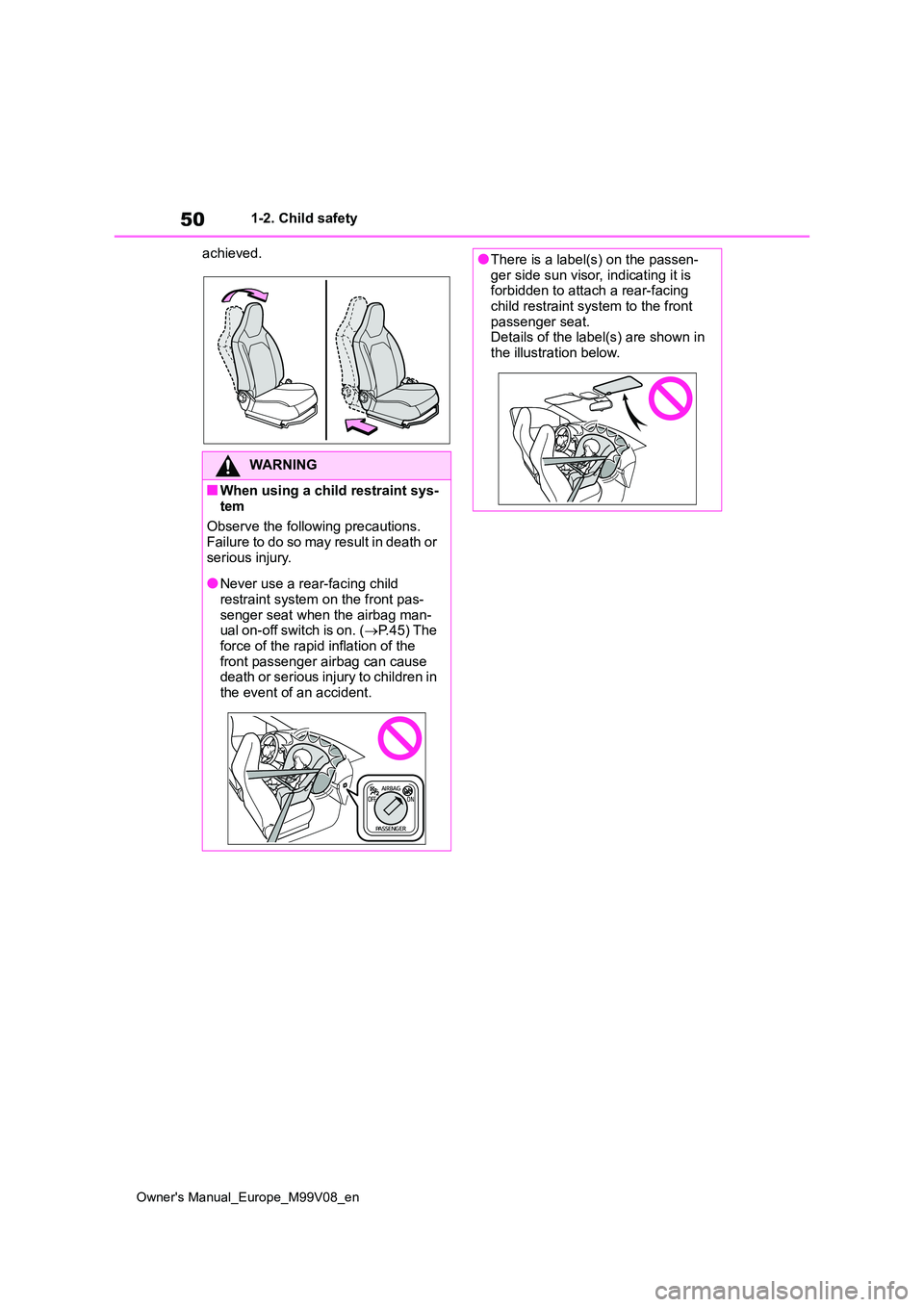
50
Owner's Manual_Europe_M99V08_en
1-2. Child safety
achieved.
WARNING
■When using a child restraint sys-
tem
Observe the following precautions. Failure to do so may result in death or
serious injury.
●Never use a rear-facing child
restraint system on the front pas- senger seat when the airbag man-ual on-off switch is on. ( P.45) The
force of the rapid inflation of the front passenger airbag can cause death or serious injury to children in
the event of an accident.
●There is a label(s) on the passen- ger side sun visor, indicating it is forbidden to attach a rear-facing
child restraint system to the front passenger seat.Details of the label(s) are shown in
the illustration below.
Page 53 of 494
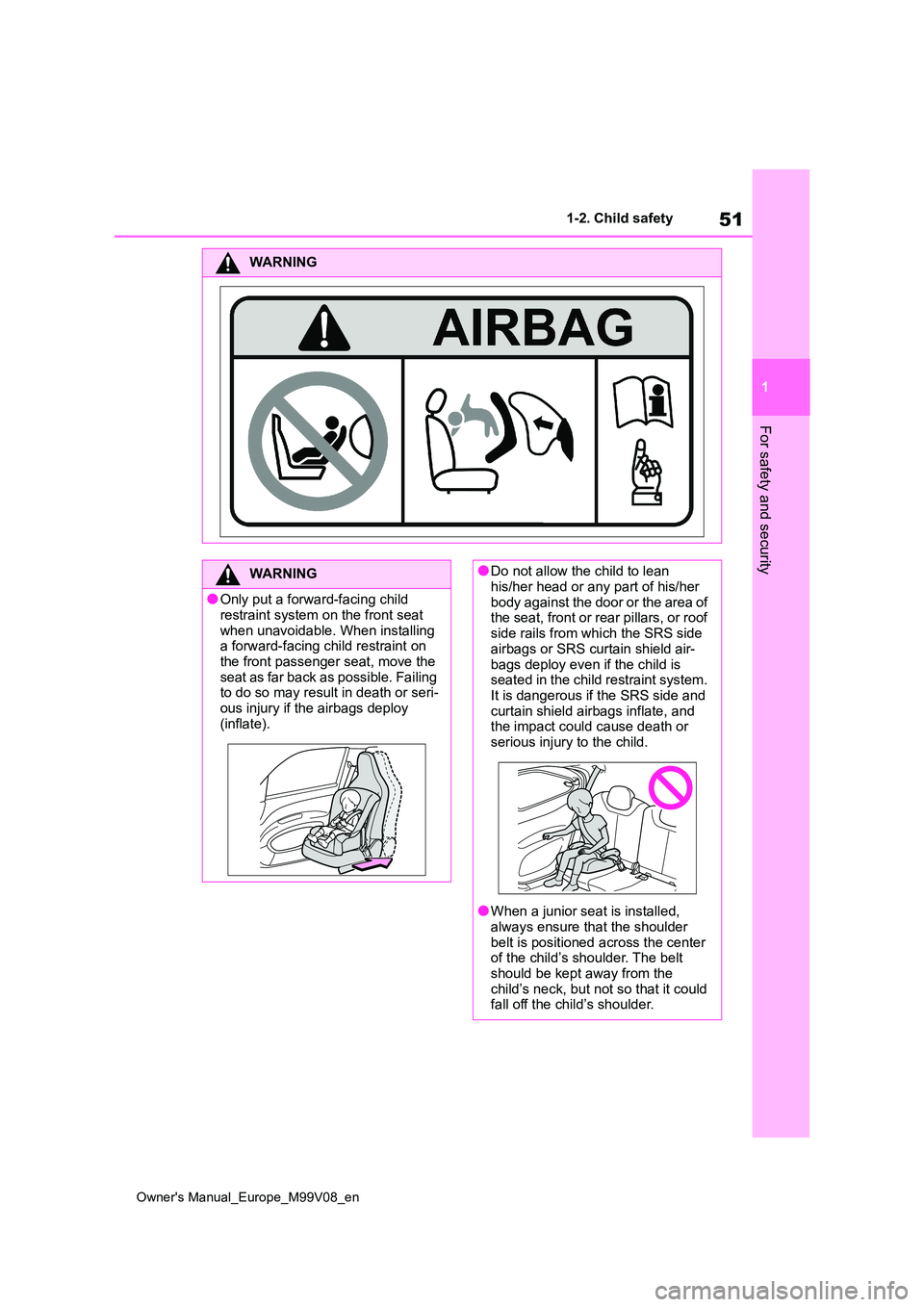
51
1
Owner's Manual_Europe_M99V08_en
1-2. Child safety
For safety and security
WARNING
WARNING
●Only put a forward-facing child restraint system on the front seat
when unavoidable. When installing a forward-facing child restraint on the front passenger seat, move the
seat as far back as possible. Failing to do so may result in death or seri-ous injury if the airbags deploy
(inflate).
●Do not allow the child to lean
his/her head or any part of his/her body against the door or the area of the seat, front or rear pillars, or roof
side rails from which the SRS side airbags or SRS curtain shield air-
bags deploy even if the child is seated in the child restraint system. It is dangerous if the SRS side and
curtain shield airbags inflate, and the impact could cause death or serious injury to the child.
●When a junior seat is installed, always ensure that the shoulder
belt is positioned across the center of the child’s shoulder. The belt should be kept away from the
child’s neck, but not so that it could fall off the child’s shoulder.
Page 54 of 494
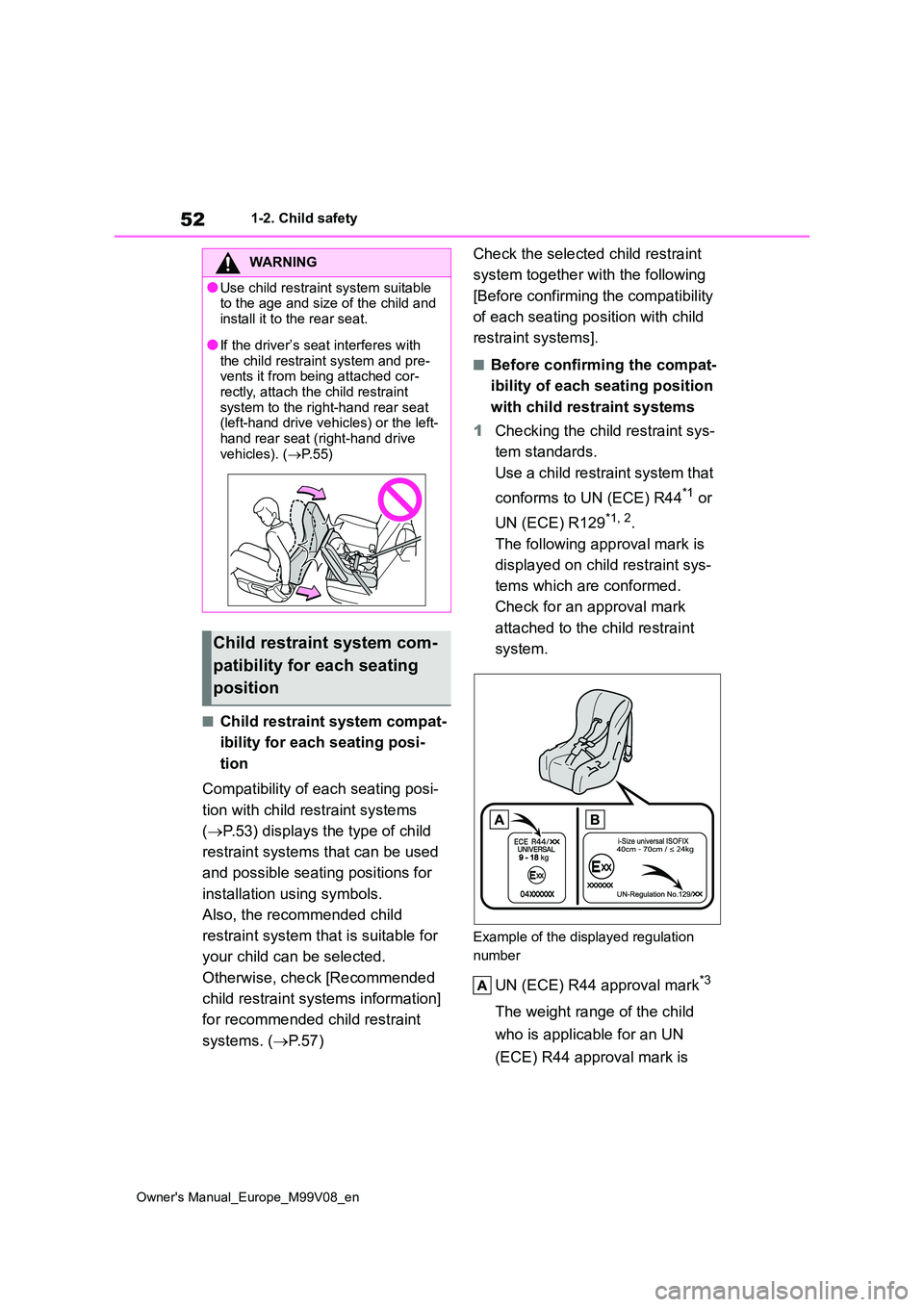
52
Owner's Manual_Europe_M99V08_en
1-2. Child safety
■Child restraint system compat-
ibility for each seating posi-
tion
Compatibility of each seating posi-
tion with child restraint systems
( P.53) displays the type of child
restraint systems that can be used
and possible seating positions for
installation using symbols.
Also, the recommended child
restraint system that is suitable for
your child can be selected.
Otherwise, check [Recommended
child restraint systems information]
for recommended child restraint
systems. ( P. 5 7 )
Check the selected child restraint
system together with the following
[Before confirming the compatibility
of each seating position with child
restraint systems].
■Before confirming the compat-
ibility of each seating position
with child restraint systems
1 Checking the child restraint sys-
tem standards.
Use a child restraint system that
conforms to UN (ECE) R44*1 or
UN (ECE) R129*1, 2.
The following approval mark is
displayed on child restraint sys-
tems which are conformed.
Check for an approval mark
attached to the child restraint
system.
Example of the displayed regulation
number
UN (ECE) R44 approval mark*3
The weight range of the child
who is applicable for an UN
(ECE) R44 approval mark is
WARNING
●Use child restraint system suitable to the age and size of the child and
install it to the rear seat.
●If the driver’s seat interferes with
the child restraint system and pre- vents it from being attached cor-rectly, attach the child restraint
system to the right-hand rear seat (left-hand drive vehicles) or the left-hand rear seat (right-hand drive
vehicles). ( P. 5 5 )
Child restraint system com-
patibility for each seating
position
Page 55 of 494
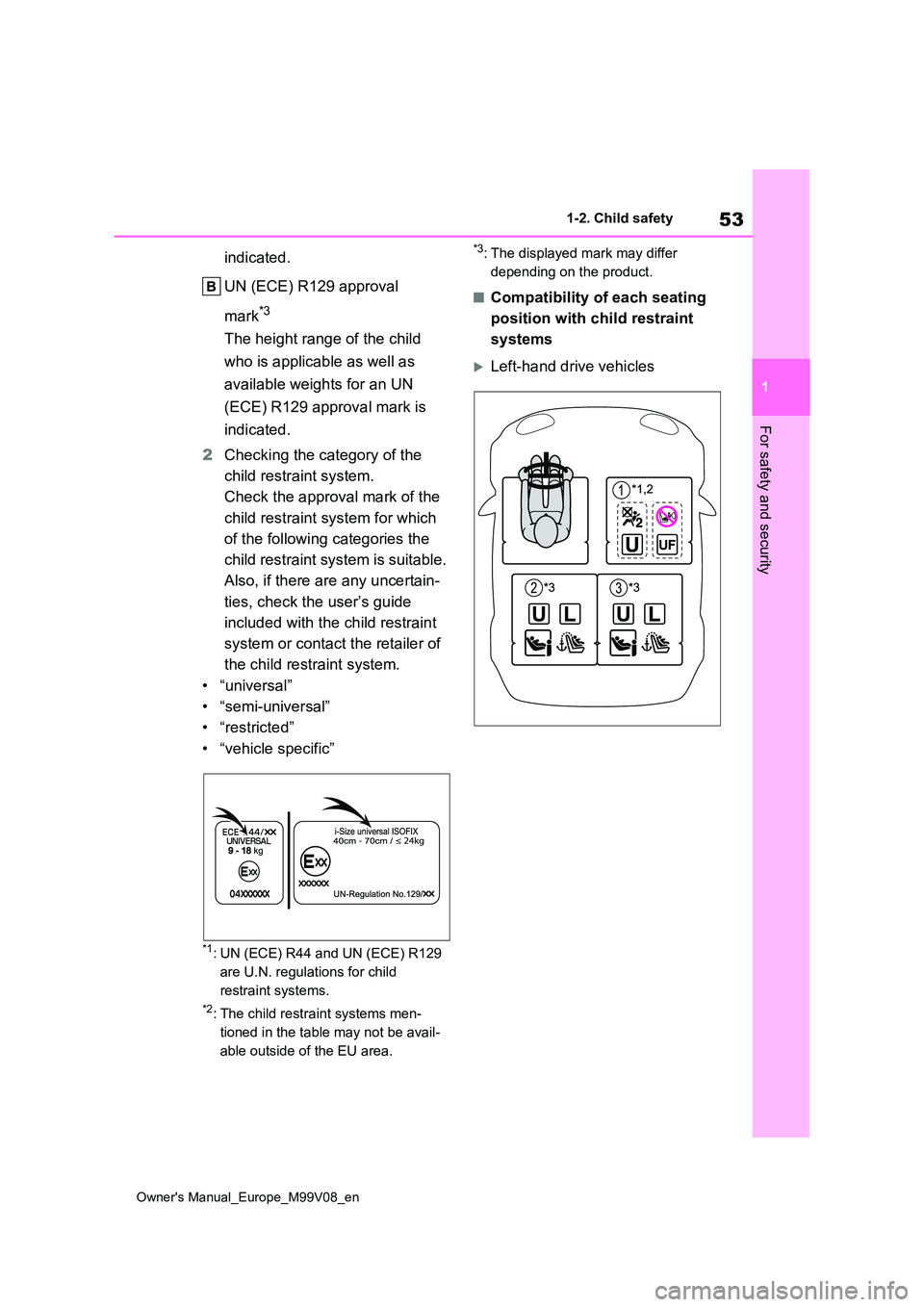
53
1
Owner's Manual_Europe_M99V08_en
1-2. Child safety
For safety and security
indicated.
UN (ECE) R129 approval
mark*3
The height range of the child
who is applicable as well as
available weights for an UN
(ECE) R129 approval mark is
indicated.
2 Checking the category of the
child restraint system.
Check the approval mark of the
child restraint system for which
of the following categories the
child restraint system is suitable.
Also, if there are any uncertain-
ties, check the user’s guide
included with the child restraint
system or contact the retailer of
the child restraint system.
•“universal”
• “semi-universal”
• “restricted”
• “vehicle specific”
*1: UN (ECE) R44 and UN (ECE) R129
are U.N. regulations for child
restraint systems.
*2: The child restraint systems men-
tioned in the table may not be avail-
able outside of the EU area.
*3: The displayed mark may differ
depending on the product.
■Compatibility of each seating
position with child restraint
systems
Left-hand drive vehicles
Page 56 of 494
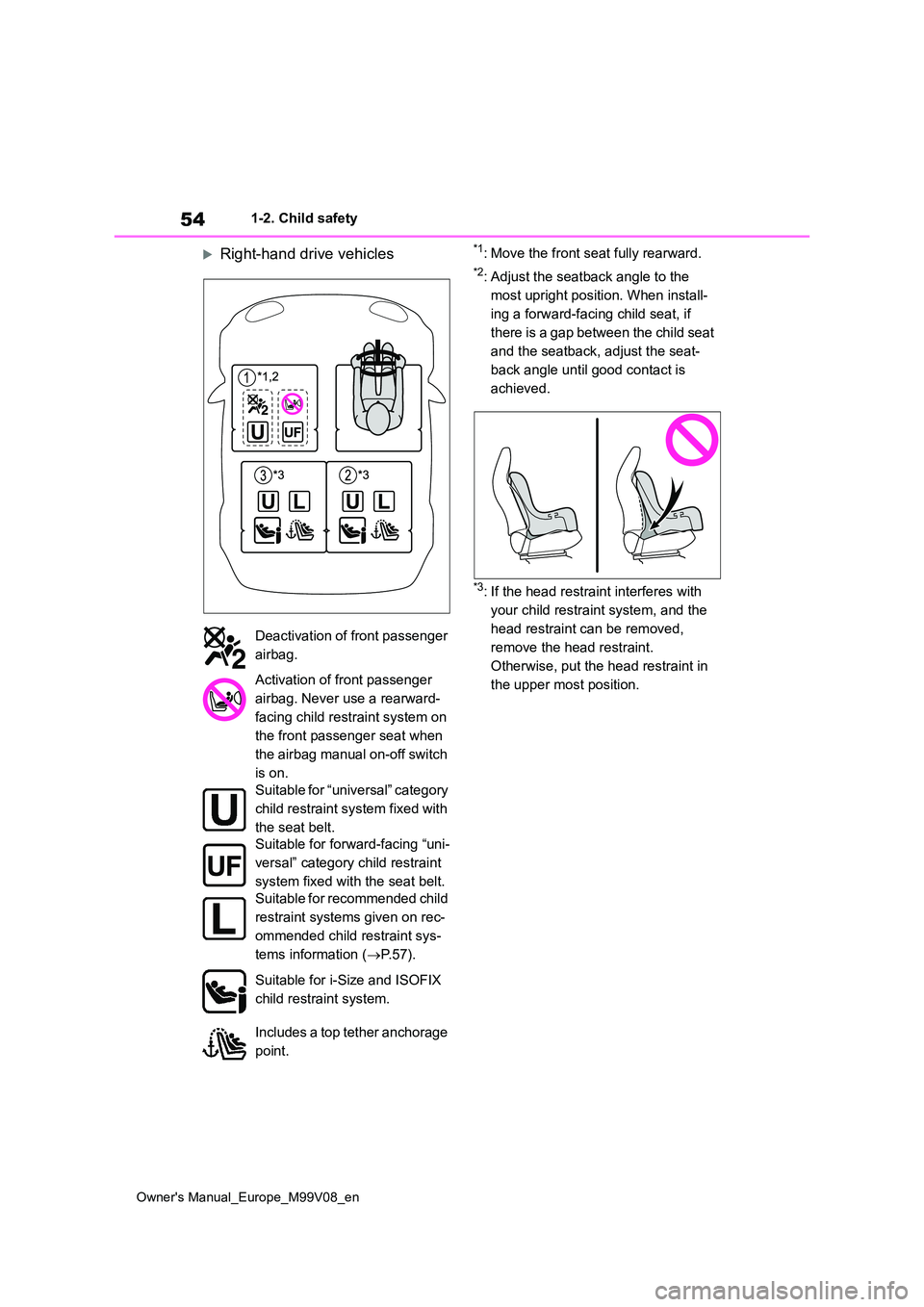
54
Owner's Manual_Europe_M99V08_en
1-2. Child safety
Right-hand drive vehicles*1: Move the front seat fully rearward.
*2: Adjust the seatback angle to the
most upright position. When install-
ing a forward-facing child seat, if
there is a gap between the child seat
and the seatback, adjust the seat-
back angle until good contact is
achieved.
*3: If the head restraint interferes with
your child restraint system, and the
head restraint can be removed,
remove the head restraint.
Otherwise, put the head restraint in
the upper most position.
Deactivation of front passenger
airbag.
Activation of front passenger
airbag. Never use a rearward-
facing child restraint system on
the front passenger seat when
the airbag manual on-off switch
is on.
Suitable for “universal” category
child restraint system fixed with
the seat belt.
Suitable for forward-facing “uni-
versal” category child restraint
system fixed with the seat belt.
Suitable for recommended child
restraint systems given on rec-
ommended child restraint sys-
tems information ( P. 5 7 ) .
Suitable for i-Size and ISOFIX
child restraint system.
Includes a top tether anchorage
point.
Page 57 of 494
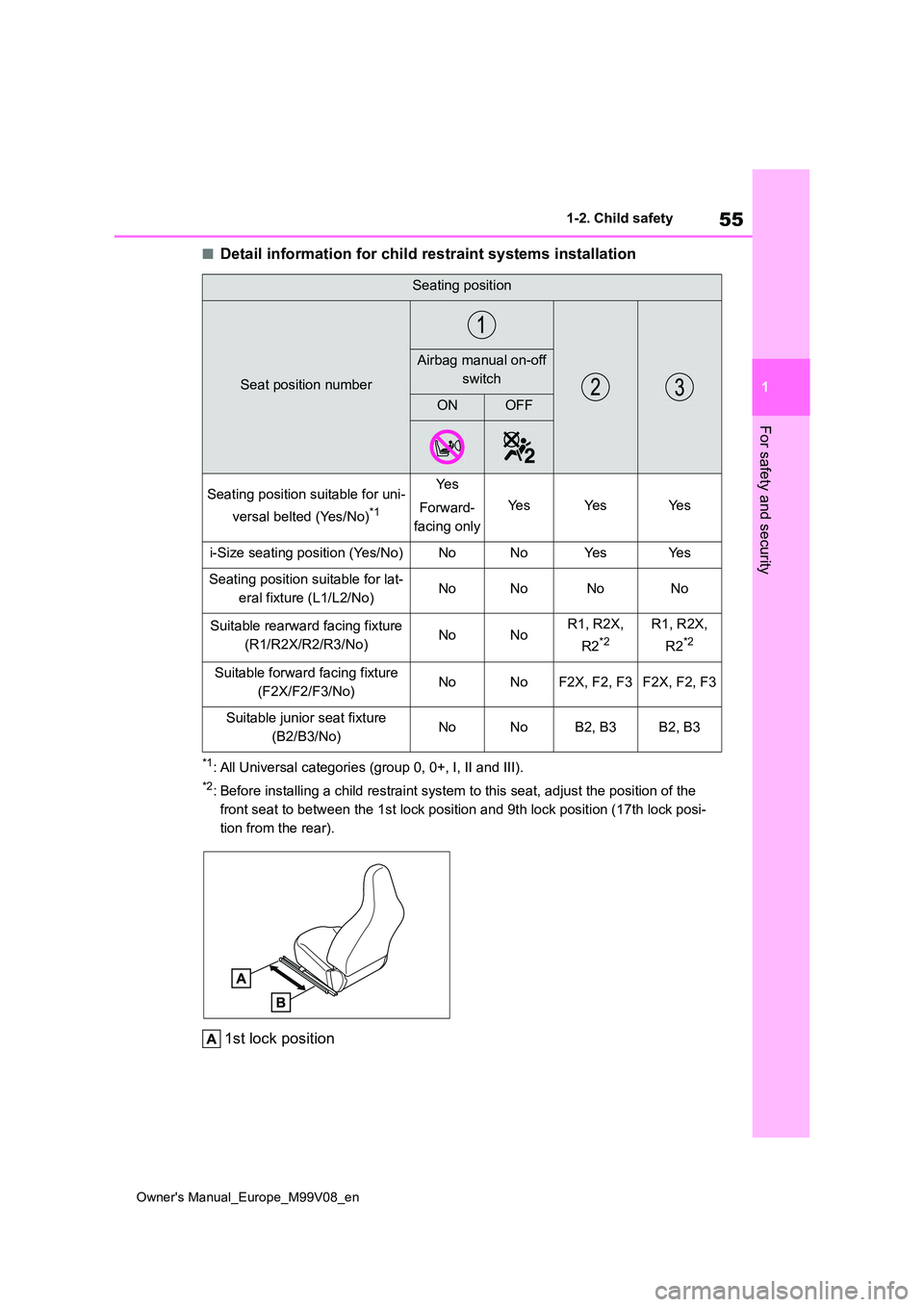
55
1
Owner's Manual_Europe_M99V08_en
1-2. Child safety
For safety and security
■Detail information for child restraint systems installation
*1: All Universal categories (group 0, 0+, I, II and III).
*2: Before installing a child restraint system to this seat, adjust the position of the
front seat to between the 1st lock position and 9th lock positi on (17th lock posi-
tion from the rear).
1st lock position
Seating position
Seat position number
Airbag manual on-off
switch
ONOFF
Seating position suitable for uni-
versal belted (Yes/No)*1
Ye s
Forward-
facing only
Ye sYe sYe s
i-Size seating position (Yes/No)NoNoYe sYe s
Seating position suitable for lat-
eral fixture (L1/L2/No)NoNoNoNo
Suitable rearward facing fixture
(R1/R2X/R2/R3/No)NoNoR1, R2X,
R2*2
R1, R2X,
R2*2
Suitable forward facing fixture
(F2X/F2/F3/No)NoNoF2X, F2, F3F2X, F2, F3
Suitable junior seat fixture
(B2/B3/No)NoNoB2, B3B2, B3
Page 58 of 494
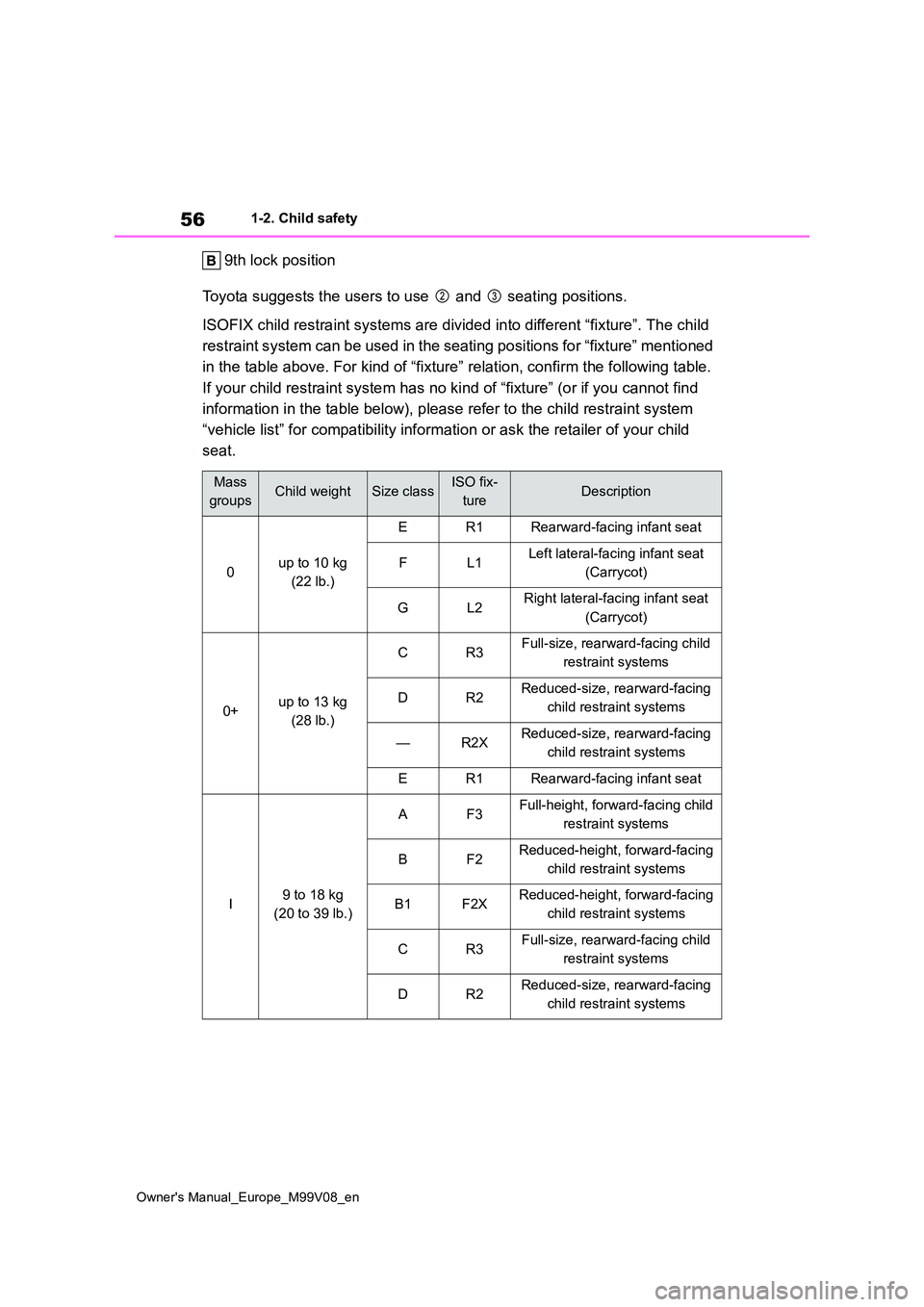
56
Owner's Manual_Europe_M99V08_en
1-2. Child safety
9th lock position
Toyota suggests the users to use and seating positions.
ISOFIX child restraint systems are divided into different “fixt ure”. The child
restraint system can be used in the seating positions for “fixt ure” mentioned
in the table above. For kind of “ fixture” relation, confirm the following table.
If your child restraint system ha s no kind of “fixture” (or if you cannot find
information in the table below), please refer to the child rest raint system
“vehicle list” for compatibility information or ask the retaile r of your child
seat.
Mass
groupsChild weightSize classISO fix-
tureDescription
0up to 10 kg
(22 lb.)
ER1Rearward-facing infant seat
FL1Left lateral-facing infant seat
(Carrycot)
GL2Right lateral-facing infant seat
(Carrycot)
0+up to 13 kg
(28 lb.)
CR3Full-size, rearward-facing child
restraint systems
DR2Reduced-size, rearward-facing
child restraint systems
—R2XReduced-size, rearward-facing
child restraint systems
ER1Rearward-facing infant seat
I9 to 18 kg
(20 to 39 lb.)
AF3Full-height, forward-facing child
restraint systems
BF2Reduced-height, forward-facing
child restraint systems
B1F2XReduced-height, forward-facing
child restraint systems
CR3Full-size, rearward-facing child
restraint systems
DR2Reduced-size, rearward-facing
child restraint systems
Page 59 of 494
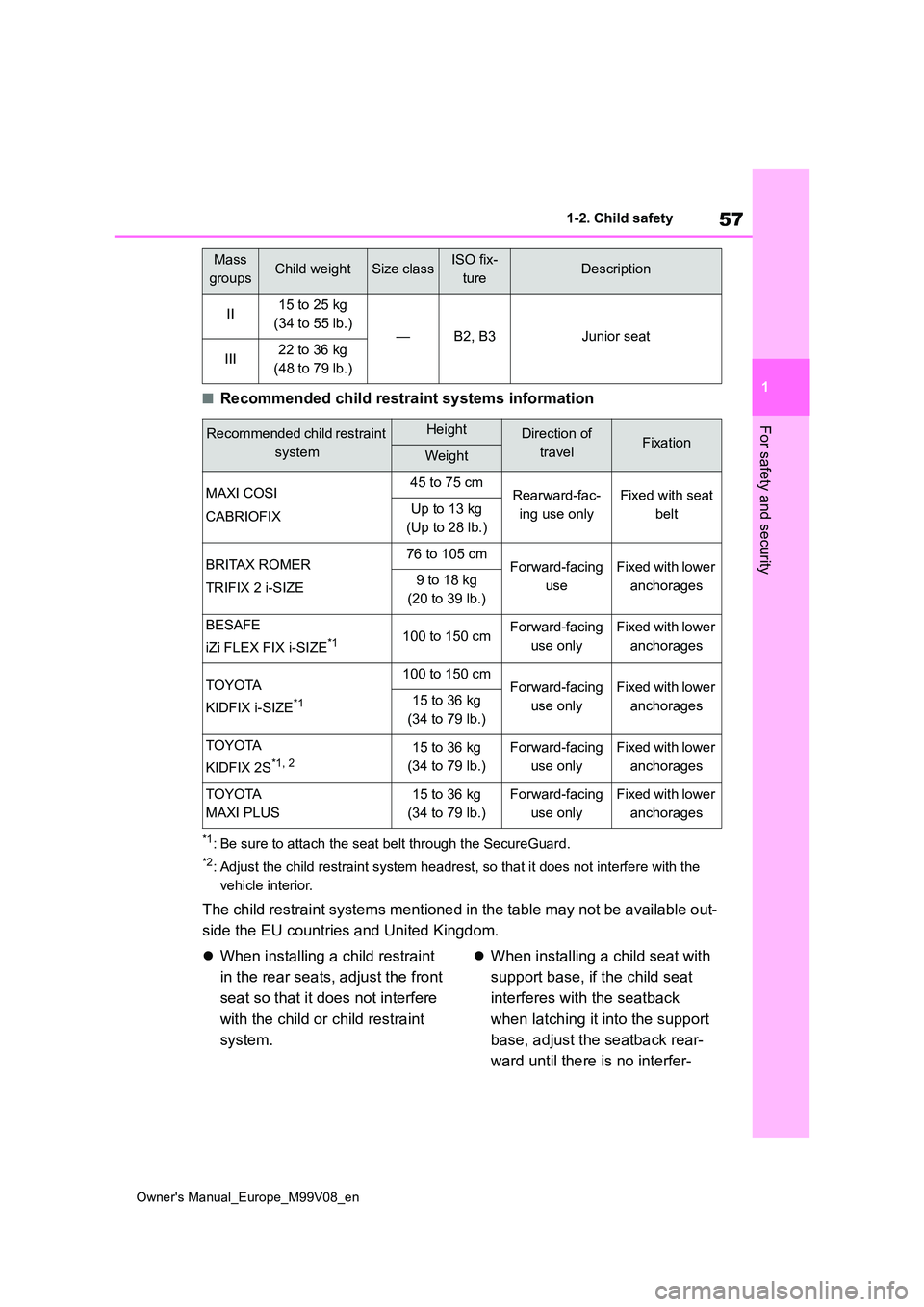
57
1
Owner's Manual_Europe_M99V08_en
1-2. Child safety
For safety and security
■Recommended child restraint systems information
*1: Be sure to attach the seat belt through the SecureGuard.
*2: Adjust the child restraint system headrest, so that it does not interfere with the
vehicle interior.
The child restraint systems mentioned in the table may not be a vailable out-
side the EU countries and United Kingdom.
When installing a child restraint
in the rear seats, adjust the front
seat so that it does not interfere
with the child or child restraint
system.
When installing a child seat with
support base, if the child seat
interferes with the seatback
when latching it into the support
base, adjust the seatback rear-
ward until there is no interfer-
II15 to 25 kg
(34 to 55 lb.)—B2, B3Junior seat
III22 to 36 kg
(48 to 79 lb.)
Recommended child restraint
system
HeightDirection of
travelFixationWeight
MAXI COSI
CABRIOFIX
45 to 75 cmRearward-fac-
ing use only
Fixed with seat
beltUp to 13 kg
(Up to 28 lb.)
BRITAX ROMER
TRIFIX 2 i-SIZE
76 to 105 cmForward-facing
use
Fixed with lower
anchorages9 to 18 kg
(20 to 39 lb.)
BESAFE
iZi FLEX FIX i-SIZE*1100 to 150 cmForward-facing
use only
Fixed with lower
anchorages
TOYOTA
KIDFIX i-SIZE*1
100 to 150 cmForward-facing
use only
Fixed with lower
anchorages15 to 36 kg
(34 to 79 lb.)
TOYOTA
KIDFIX 2S*1, 215 to 36 kg
(34 to 79 lb.)
Forward-facing
use only
Fixed with lower
anchorages
TOYOTA
MAXI PLUS
15 to 36 kg
(34 to 79 lb.)
Forward-facing
use only
Fixed with lower
anchorages
Mass
groupsChild weightSize classISO fix-
tureDescription
Page 60 of 494
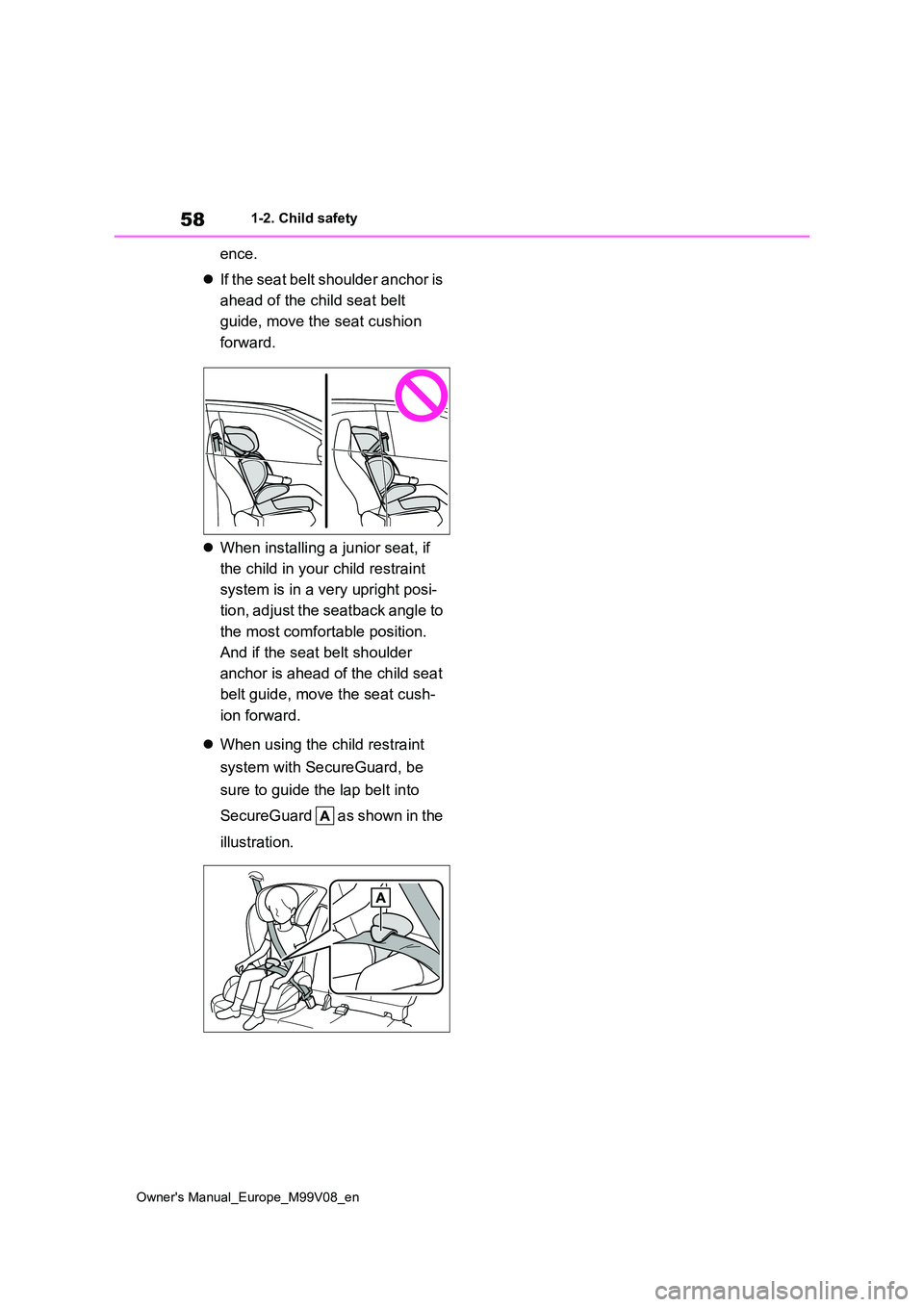
58
Owner's Manual_Europe_M99V08_en
1-2. Child safety
ence.
If the seat belt shoulder anchor is
ahead of the child seat belt
guide, move the seat cushion
forward.
When installing a junior seat, if
the child in your child restraint
system is in a very upright posi-
tion, adjust the seatback angle to
the most comfortable position.
And if the seat belt shoulder
anchor is ahead of the child seat
belt guide, move the seat cush-
ion forward.
When using the child restraint
system with SecureGuard, be
sure to guide the lap belt into
SecureGuard as shown in the
illustration.